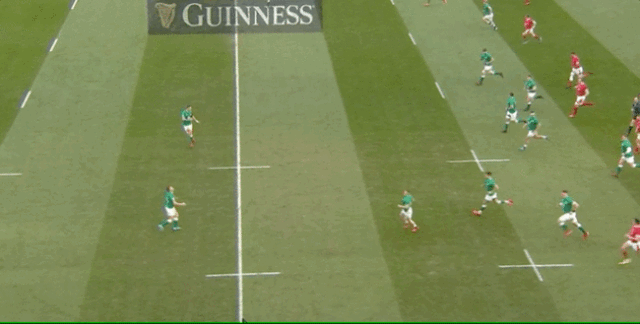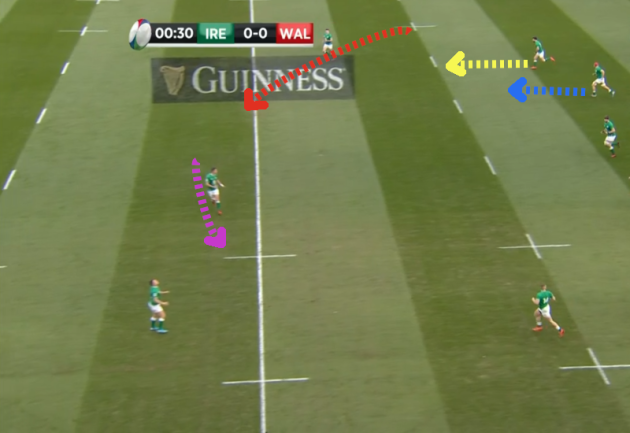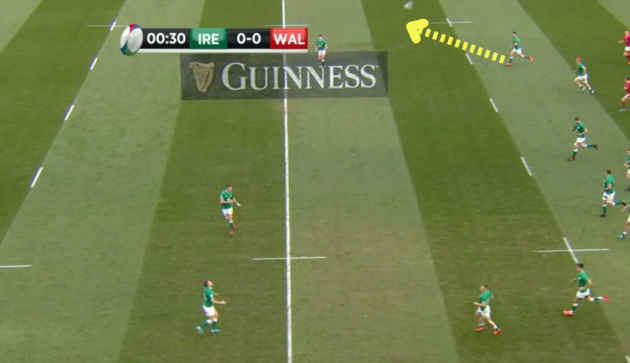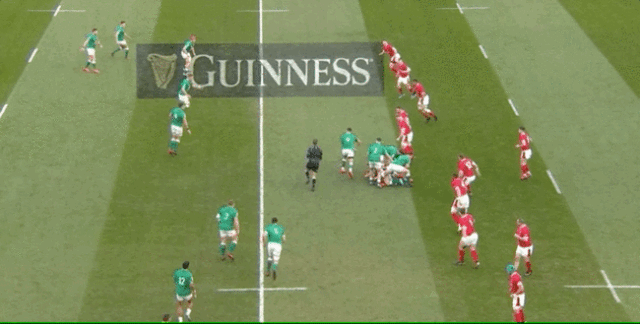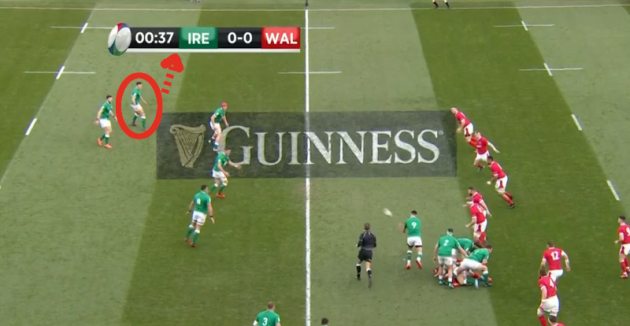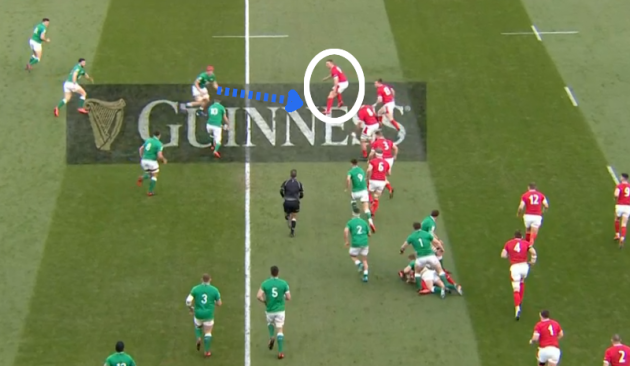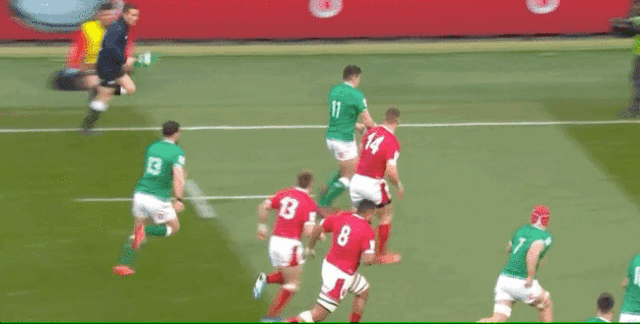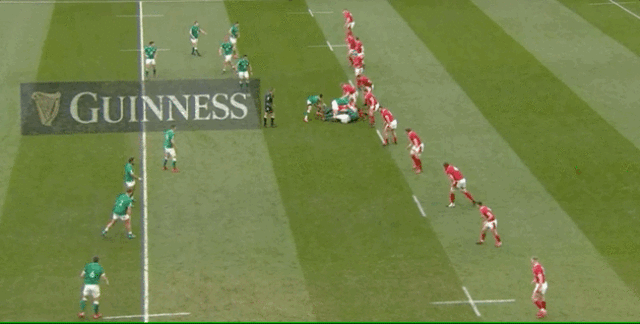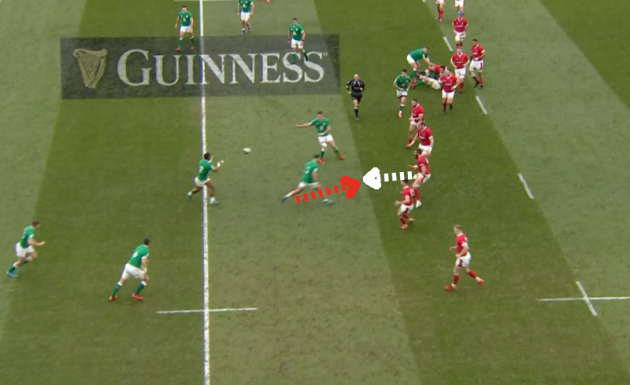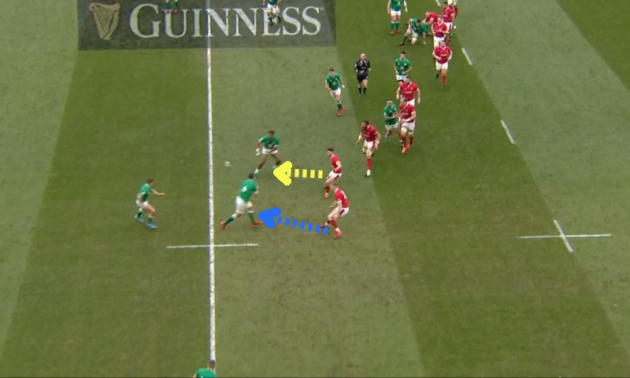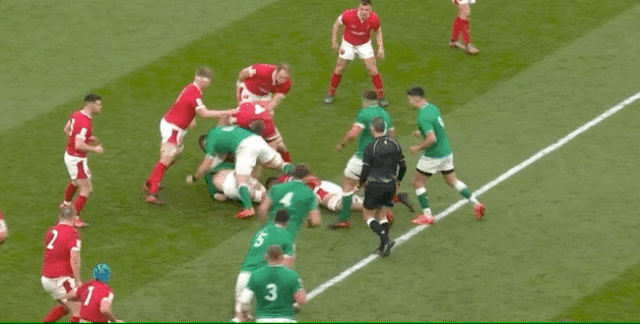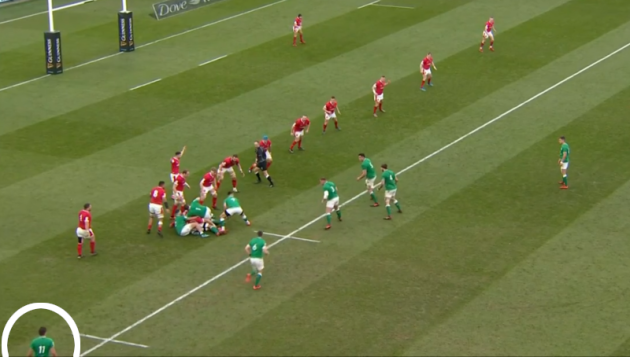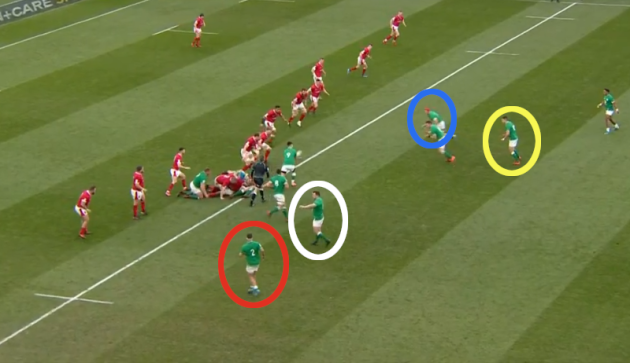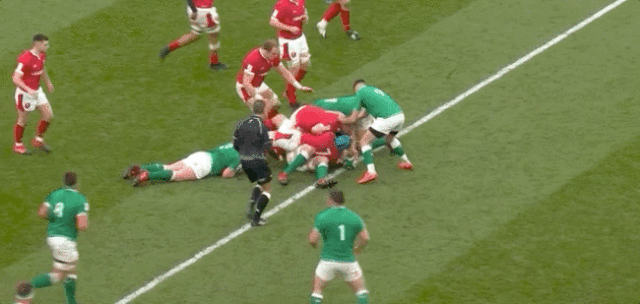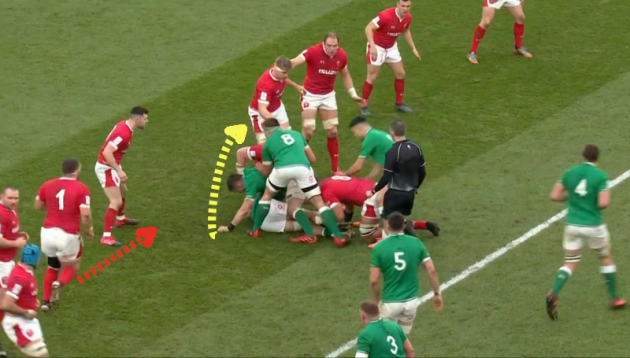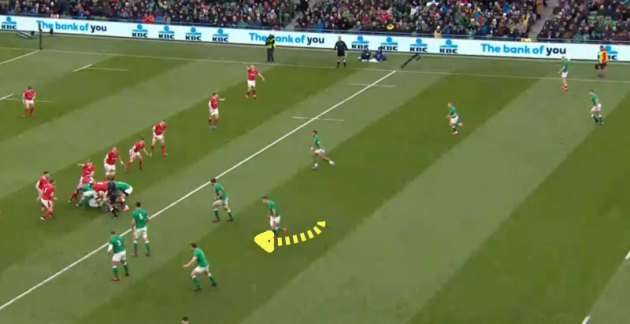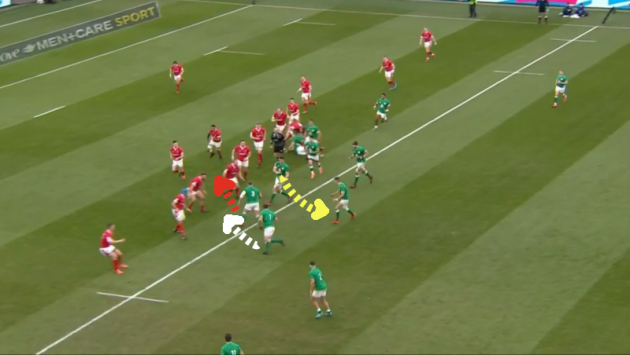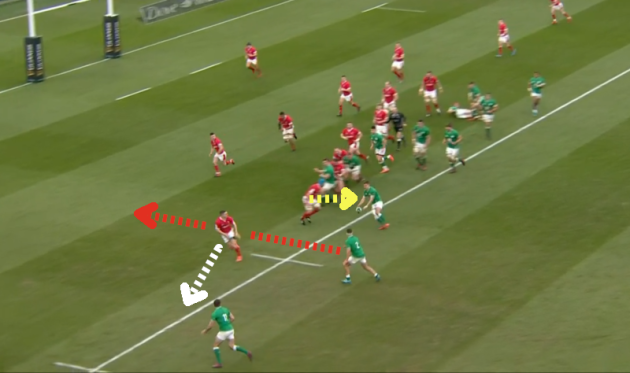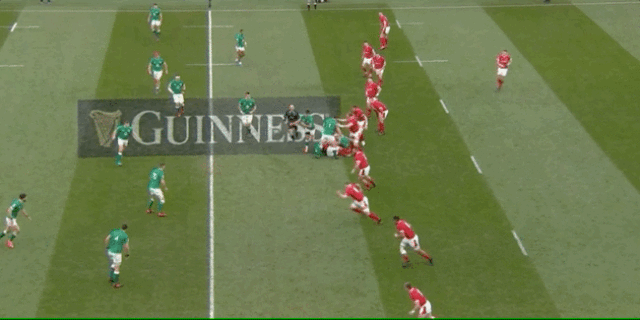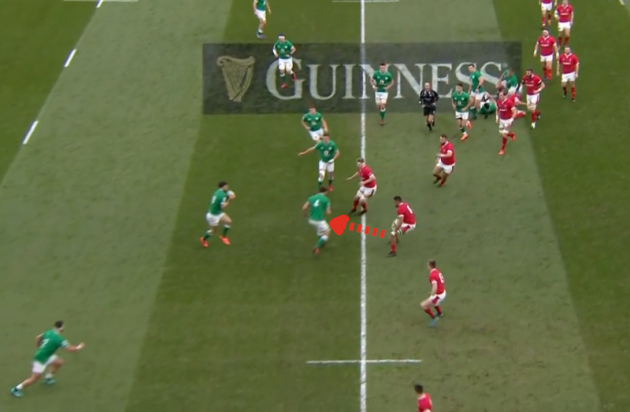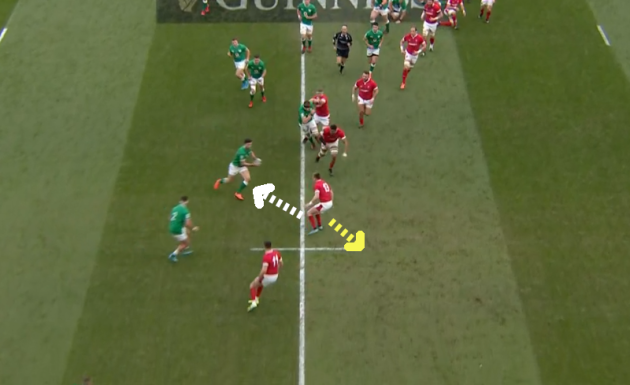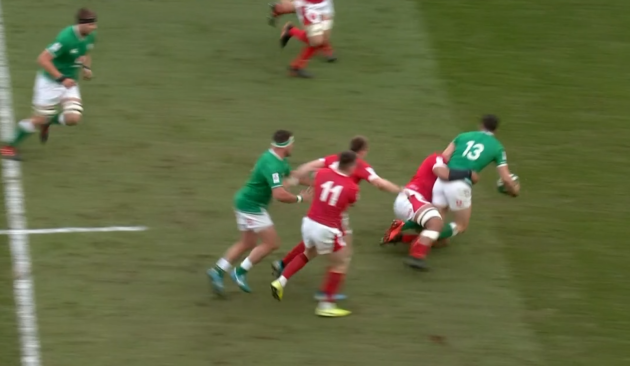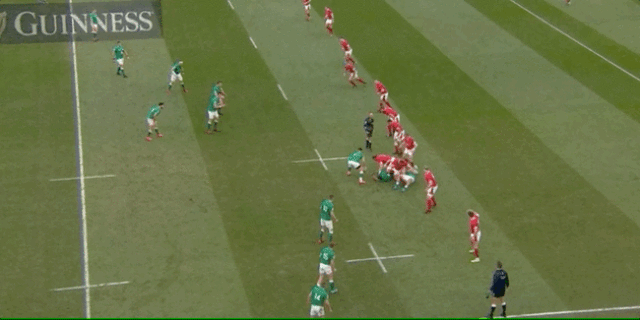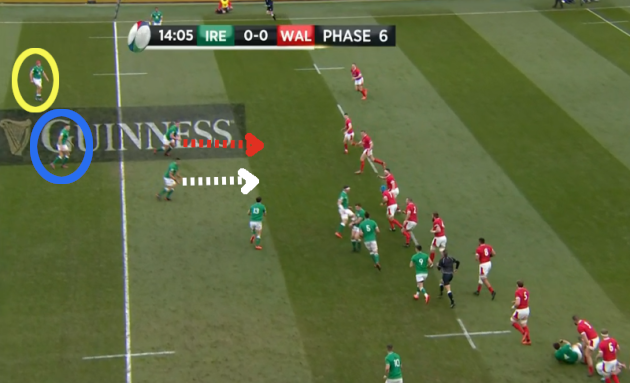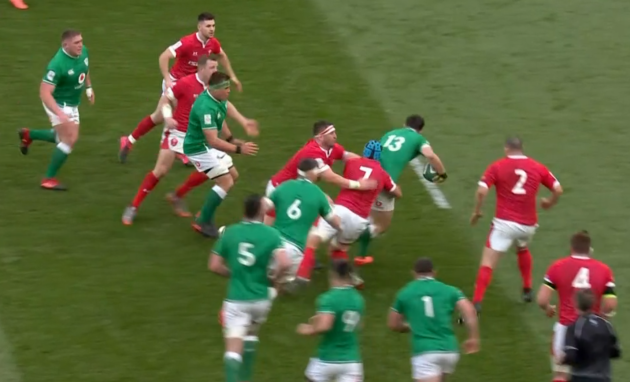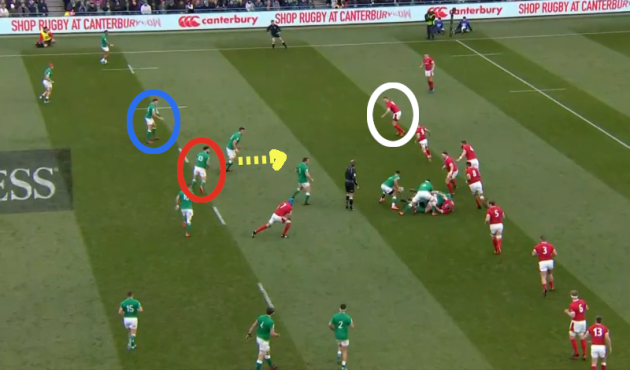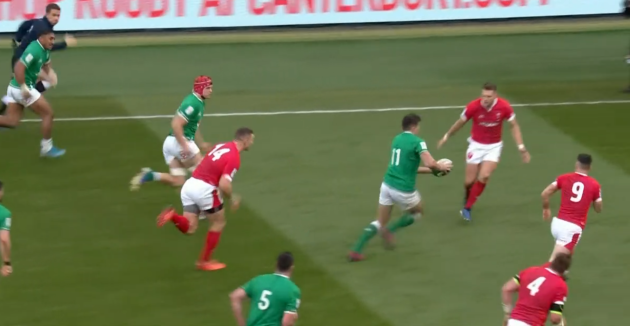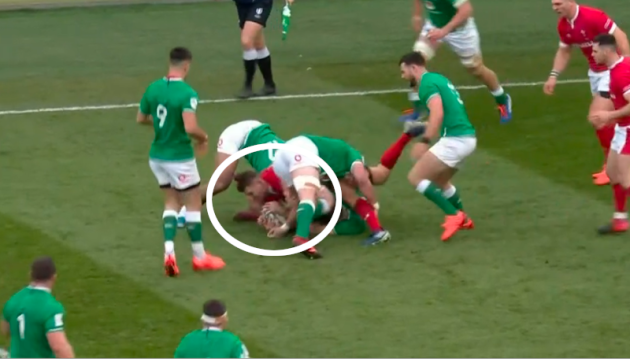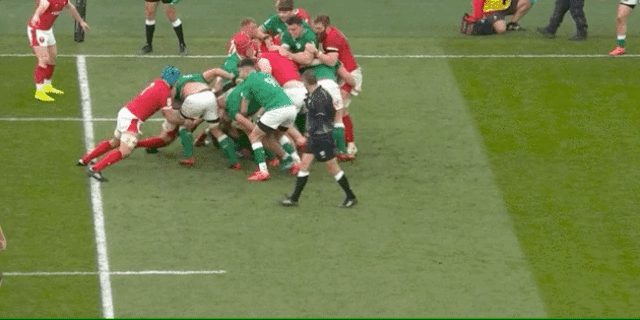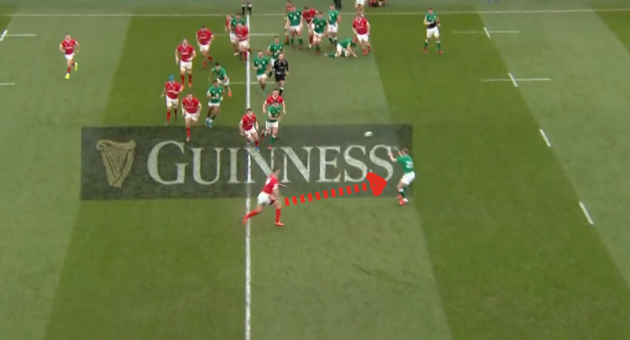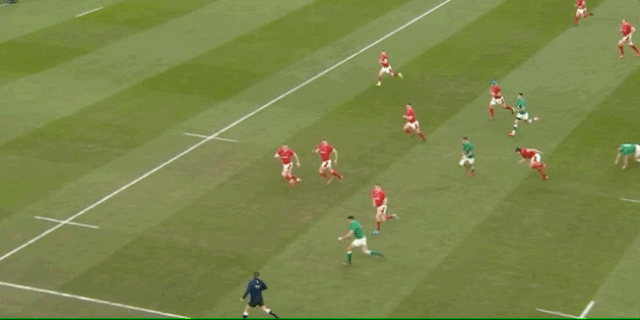LAST UPDATE | 10 Feb 2020
A WEEK ON from making five linebreaks against Scotland, Andy Farrell’s Ireland delivered a more cohesive and fluid attacking performance to double that return to 10 linebreaks versus Wales with almost exactly the same amount of possession.
While all four of Ireland’s tries came from set-pieces inside the Wales 22 – two lineouts and two scrums – they also offered a real threat through their phase-play attack originating from turnovers or receiving kicks from the Welsh.
Ireland have long been renowned as a brilliant set-piece attack team and it is vital that they continue to excel in that department, but it’s evident that they are attempting to be more dangerous away from lineout and scrum strikes too.
These are still early days for Ireland under Farrell and new attack coach Mike Catt, but the signs in the opening two games of this Six Nations have been encouraging.
There was an indicator of Ireland’s attacking intent in the very opening minute of the win over the Welsh on Saturday, as a sharp counter-attack produced a five-metre scrum that could have allowed Farrell’s men to take a very early lead.
[Click here if you cannot view the clip above]
Wales exit from their 22 after the opening kick-off of the game and Ireland fullback Jordan Larmour fields before running back at the Welsh.
We’re more interested in what’s happening off the ball as Larmour gets set to field the ball.
As Eoin Toolan discussed in his article on Ireland’s counter-attack last week, there was real scope for improvement in how they provided support to Larmour as they looked to return opposition kicks.
In this instance, Johnny Sexton [pink below] shifts cross-field to offer support close to Larmour, while Jacob Stockdale [red] retreats from the edge of the defence and in towards Sexton.
Robbie Henshaw [yellow] and Josh van der Flier [blue] are also working back downfield, although they could perhaps have left a little earlier.
As Eoin pointed out last week, the second-last defender in the frontline – Henshaw in this instance – can provide width for counter-attacks by working towards the far touchline.
So in this case, Henshaw might have worked to the left touchline [yellow below] as Stockdale shifted infield towards the ball.
Even still, Ireland’s work off the ball gives them a chance to counter on the phase after Larmour carries.
The fullback runs diagonally towards a group of his retreating forwards, looking to slip through any doors they can open by subtly escorting Wales’ chase line, but Alun Wyn Jones tackles him. Ireland immediately move the ball left.
[Click here if you cannot view the clip above]
With Larmour having worked across the pitch and the recycle being so quick, we can see that Wales are caught very narrow to the ruck.
Ireland are narrow themselves as the phase begins, with Stockdale [red below] having initially come infield only for Henshaw to retreat to the same area rather than providing the width out on the left.
Stockdale recognises that rapidly, however, and shifts into a wider position as Conor Murray hits Sexton with the pass.
A simple screen play from Sexton behind van der Flier [blue below] briefly holds George North [white] on the edge of the Wales defence.
The timing of the run from the hard-working van der Flier is good. As we can see above, he’s actually a realistic target for a Sexton pass, rather than ahead of the ball.
Instead, Sexton goes out the back door to the deeper-lying Henshaw, who straightens intelligently to North’s inside shoulder, again delaying the Wales wing’s drift and buying Stockdale more time and space outside.
As the ball arrives to Ireland’s left wing, Wales fullback Leigh Halfpenny is closing up from the backfield and we see that characteristic Stockdale left-footed chip in behind.
[Click here if you cannot view the clip above]
It’s an excellent kick from Stockdale to take advantage of how Ireland have manipulated the Welsh defence and it leaves Dan Biggar in a tricky situation as the ball bounces past him and bobbles low on the ground.
Biggar hesitates and the excellent chase from van der Flier, Sexton, and co. forces him to carry over his own tryline and hand Ireland a five-metre scrum.
Frustratingly, Ireland are penalised by referee Romain Poite at that scrum but the counter-attack was promising.
We saw a similar chip kick down the right-hand side from Conway later in the first half following more good passing from Ireland after they had returned a Welsh exiting box kick.
[Click here if you cannot view the clip above]
A midfield ruck for Ireland means Wales can’t come forward with huge linespeed as they mark up on both sides, and the home team use the two forwards on their right-hand side cleverly as they get the ball wide again.
First, Sexton screens hooker Rob Herring [red below], whose run manages to briefly attract Jake Ball [white] in the Wales defensive line.
Ball’s slight hesitation in sticking on Herring means that Tomos Williams outside is now concerned about the running threat of Bundee Aki as he receives the pass from Sexton, having held his depth nicely.
Williams now sticks on Aki [yellow below] as Peter O’Mahony runs the second screen outside Aki, convincing Wales edge defender Johnny McNicholl [blue] that he needs to respect the possible front-door option.
While McNicholl does then drift beyond O’Mahony as Aki goes out the back door to Larmour, the Ireland fullback can draw the Wales wing in towards him before passing to Conway in space.
Williams scrambles hard across from the inside to cover Conway but the Ireland wing repeats Stockdale’s actions with a clever chip ahead.
[Click here if you cannot view the clip above]
It’s the exact opposite scenario this time, as Biggar closes up from the backfield and Conway targets the space in behind him, as Halfpenny covers across.
Ideally, the ball stays infield on this chip kick and Ireland can apply pressure to Halfpenny, possibly driving him into touch.
However, it works out very well for Ireland from the ensuing Welsh lineout as Williams knocks-on and Ireland score through Tadhg Furlong on third phase from the scrum.
While Ireland use forwards as decoys in the examples above, they also threatened in instances where forwards actually handled the ball.
We get a nice example below, soon after O’Mahony has stolen a Welsh lineout. Ireland play three one-out phases infield before swinging back to their left as Sexton slides underneath the midfield ruck.
[Click here if you cannot view the clip above]
Ireland’s ability to keep width on their left-hand side even as they play infield is important here.
As we can see below, Stockdale [white] holds in the left-hand 15-metre channel as Ireland attack from the lineout steal.
Ireland make another carry to the right and then as they launch their third carry infield, there is more evidence of players making good decisions to ensure their team is a threat on both sides of the ruck.
Having hit the very first ruck in this turnover attack, Cian Healy [white below] and Herring [red] reload straight back down the pitch, rather than chasing the ball.
We can see Healy organising as Murray moves the ball right for van der Flier [blue] to carry, with Sexton [yellow] in behind.
Importantly, van der Flier makes a superb carry here. Note below how he is actually taking a slight step backwards as Murray passes, ensuring that he is actually then running onto the ball at pace.
[Click here if you cannot view the clip above]
The pace at which van der Flier comes onto the ball allows him to dominate the first contact with Taulupe Faletau and then he fights forward as O’Mahony latches on impactfully to help him gain a few metres for Ireland.
Wales move to fold around the corner in defence again after van der Flier’s carry, with Aaron Wainwright [yellow below] getting around and Wyn Jones [red] closing towards the ruck.
As we can see below, Ireland are indeed a threat wide to the right, with Aki, Keith Earls, Larmour and Conway all out to that side of the ruck, but now Sexton [yellow below] cleverly decides to swing back to the left.
Ireland’s forwards have organised themselves well, with second row Ryan getting back to his feet from the previous carry to be the first receiver.
Furlong [red below] sets up just outside him to offer a short passing option, while Healy [white] runs a similar line slightly further out.
Instead of carrying himself or tipping-on a pass to Furlong, Ryan [yellow above] swivels to pass out the back to Sexton darting in behind the pod of forwards.
Wales’ defence is condensed around the ruck again and Sexton exploits the opportunity expertly.
The Ireland out-half delays his pass until he recognises that Tipuric is committing inwards onto him [yellow below], rather than drifting off to Herring [red], who again times his running line well.
Wales wing North [white above] is concerned about Stockdale wider out and seems to think Tipuric is indeed drifting across on his inside to Herring.
That leaves the Ireland hooker with a huge gap to burst into. North’s positioning means Herring can’t link outside to Stockdale and Wales scramble to tackle him.
In his desperation to stop Herring, Faletau flies in off his feet at the breakdown and concedes penalty advantage. Though Ireland would have loved to finish directly after this clever linebreak, they kick the penalty into the left corner and maul over through van der Flier for their third try.
Henshaw was very prominent for Ireland in the first half as they evidently looked to put him into contests with his opposite number, Nick Tompkins, who was making his first Test start.
The example below comes on an attack that starts with an Ireland lineout. However, their initial strike has yielded no gain and they are now onto seventh phase, so well beyond any pre-planned maps they had for the initial phases.
[Click here if you cannot view the clip above]
By now, the screen play is very familiar and again it is effective here as we see Faletau [red below] attracted in on Henderson in this case.
Sexton goes out the back door to Henshaw, who identifies the sliver of space that opens outside Faletau as he briefly sits down on Henderson’s running line.
With Faletau struggling to catch up on the inside, Tompkins decides to back off [yellow below] from Henshaw, hoping Faletau can get across to the Ireland centre.
Really, Tompkins needs to shut Henshaw down here, advancing forward to hit him [white above].
As we can see, Herring is running another short line outside Henshaw but Wales wing Josh Adams is closing up and in on the Wales hooker. Conway is wide but Henshaw will have to loft a pass up over Adams to get the ball there.
Tompkins needs to hammer up on Henshaw but instead sits off as the Ireland centre intelligently carries the ball in two hands and dummies a pass, but then bursts outside Faletau.
The Wales number eight does make the tackle but Henshaw has got beyond him, shielding himself with his left arm as he gets the ball through the tackle in his right arm.
Henshaw goes to ground and then offloads from his back before Faletau can slap the ball down.
Henderson gathers the offload and bumps Tompkins off as he makes more yards.
As Herring gets to the breakdown to support Henderson, the energetic Henshaw has already got back to his feet for another involvement.
Below, we can see Henshaw [red] is ‘connected’ in behind a pod of three Irish forwards to the left of the ruck.
Meanwhile, out-half Sexton [white] is set up as a first receiver on the right side of the ruck, ensuring Ireland have a two-sided attacking threat here.
With only a single player in Herring hitting the breakdown, Ireland are a little lucky to retain possession here but Wales can’t get hands onto the ball legally and Herring does a good job of clearing Dillon Lewis away before Murray shifts the ball left.
Again, we see a nice link pass from an Irish forward – Healy this time – and then another dart and offload from Henshaw.
[Click here if you cannot view the clip above]
As Henshaw gets on the ball behind the three-man pod via Healy’s link pass, we can see that he has a two-man pod outside him in the shape of Stander [white] and Furlong [red], offering him two direct ball-carrying options.
Meanwhile, openside van der Flier [yellow above] has held width out on the left, while Aki is hugging the touchline.
Ireland are essentially in their new 1-3-2-2 shape but with Henderson and Herring in the ruck, van der Flier holds the width on his own.
With Aki and van der Flier positioned out on the left, Stockdale [blue above] is infield behind the two-man pod and Henshaw could potentially go out the back door or between the two forwards to the Ulster man for Ireland to immediately threaten out wide.
But, with the Welsh defence having so many options to worry about, Henshaw decides to carry himself.
Tipuric tackles Henshaw but once again the dynamic centre bosses the contact and gets his right arm through to free it for another offload, this time to Stander working up on his left.
Ireland only offloaded six times on Saturday to Wales’ 16 but encouraging players like Henshaw to use their offloading skills when the situation offers them the chance to do so would be positive for Ireland.
Wales scrag Stander from behind here but Furlong and O’Mahony – who is coming from the three-man pod – resource the breakdown for a two-second recycle that allows Ireland to do more damage.
Ryan [yellow below], also coming from the initial three-man pod, works around the corner and is the obvious target for Murray’s next pass. The Ireland scrum-half could also screen Ryan to Henshaw [red] in behind.
But with the Wales defence once again narrowed up by the Henshaw offload and Stander’s carry, Murray instead makes an excellent decision and throws a sublime pass.
Murray identifies that North [white above] is narrow and picks out Stockdale [blue], who remains infield as van der Flier and Aki provide the width.
Murray throws a stunning pass to find Stockdale and send him hurtling outside North.
[Click here if you cannot view the clip above]
It’s one of several brilliant passes Murray threw in this game.
The power and distance Murray generates without taking a step away from the ruck is sensational.
As Stockdale scorches outside North and Biggar turns in from the outside, there is scope for the Ireland wing to pass to the outside.
Biggar quite possibly would have rotated all the way back out to the touchline and smothered van der Flier and Aki along with the advancing Halfpenny, coming from the backfield anyway, but Stockdale decides to carry on into the 22.
Referee Poite then allows Biggar to make a turnover while off his feet…
… but this excellent passage of Ireland attack is rewarded as Stander wins a turnover penalty on the very next phase.
The superb build-up play ultimately results in Ireland attacking off a five-metre lineout in the left corner.
As highlighted by all four of Ireland’s tries coming from either scrum or lineout platforms in the Wales 22, there was quality from Farrell and Catt’s men from set-piece.
Further out the pitch, there were also flashes of quality from Ireland off set-piece foundations.
The example below comes after the Irish maul – so much better on Saturday, a week after failing to fire against Scotland – trundles the Welsh pack almost 10 metres backwards.
[Click here if you cannot view the clip above]
As Ireland’s progress slows and the maul gets messy, Murray makes a good decision to break off with the ball, drawing in Wales replacement out-half Jarrod Evans and inside centre Hadleigh Parkes before offloading behind the hard-running Aki to Sexton, who draws in Tompkins.
Sexton’s pass to Earls is slightly high but the replacement outside centre – on for the injured Henshaw – adjusts superbly under huge pressure from North biting up and in on him.
Earls puts the brakes on and reaches out to his right to catch the ball early before transferring it across his body, keeping the ball and his elbows high, to get it away in the split second before North hammers him ball-and-all.
It’s a stunning catch-and-pass from Earls in the blink of an eye and it has real velocity and length in it to beautifully sit out in front of fullback Larmour hitting the line from nice depth.
Larmour draws in Wales fullback Halfpenny but as we can see below, Stockdale is very flat to his fullback just as he’s about to pass.
Stockdale has to slow and reach behind himself to gather Larmour’s pass, rather than accelerating onto it.
As we can see below, there may have been an opportunity for Stockdale to go all the way if he could have taken the pass getting up to full stride.
[Click here if you cannot view the clip above]
Wales wing McNicholl is sweeping across the backfield at pace, though, and may well have completed the tackle.
As it is, Stockdale still has plenty of space in front of him after gathering and he once again shows that Ireland had discussed kicking ahead in this kind of position out on the edge of their attack.
[Click here if you cannot view the clip above]
He grubbers upfield this time and McNicholl misses the ball as he looks to scoop it up. Instead, Parkes gathers it but he’s absolutely thumped by Sexton, who had worked hard upfield in support.
Under pressure, Parkes offloads forward to Tompkins and Ireland are awarded an attacking scrum inside the Wales 22.
The most exciting thing for Farrell and Catt is that Ireland’s attack still has major room for improvement.
But they attacked with good width, intelligent decision-making, convincing decoy-running, some excellent passing, and real energy against the Welsh at times last weekend.
As Ireland look to develop further in the coming weeks and over the remainder of 2020, the early signs are promising.
